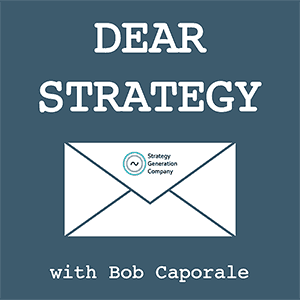Dear Strategy:
“How do you figure out a portfolio investment strategy for a product that is a delighter but doesn’t bring in money on its own?”
Back in Episode 2 and again in Episode 38, I answered questions about “non-revenue generating products” that, on the surface, may seem somewhat similar to this one. In those posts, I talked about the fact that, like it or not, most companies need to make some amount of money in order to sustain themselves. So, if you have “non-revenue generating products,” chances are, they’re going to have to be tied to some sort of revenue-generating products or services at some point in time. Otherwise, you probably won’t have much of a business to be asking questions about in the first place.
What makes this week’s question just a bit different is that the product here is noted as being a “delighter,” which implies that it is, in fact, generating some sort of revenue. The problem, however, is that it isn’t generating any profit – which presents an entirely different set of challenges. So, let’s see what happens when we add that little twist to our story.
Smartly, the question already guides us to the first part of my answer, which is that you have to first look to your overall portfolio strategy. And this is where the similarities to non-revenue generating products might come in – meaning that you may be using this “delighter” product as a kind of lure or lead-in to other, more profitable products or services that exist within your portfolio. We see this strategy in play all the time when companies offer high-cost items at lower than desirable prices, but then rely on higher-priced accessories or supplemental services to carry the overall profitability of the portfolio. An example of this strategy can be seen in the automotive industry where dealers aren’t necessarily making a lot of money on the cars, but they are making a nice profit on the associated services, financing, extended warranties, etc.
Another strategy can be seen when companies engage in what we refer to as “market penetration” pricing. In this scenario, you might have a company that is offering a product at a lower than average price in order to quickly gain recognition and share in a given market. The idea, of course, is that once the target market is penetrated, the company would then begin offering their products at somewhat higher prices. Although this strategy can be effective, it can also be pretty difficult to pull off successfully unless you’re willing to add some type of additional value to your customers at the same time you decide to raise their prices. In other words, if a company penetrates a market with a low-price, low-margin product in order to gain brand recognition, and then begins offering a higher-value, higher-margin product once their company is more well-known, then market penetration pricing can work fairly well. However, if a company offers a product at some “low introductory price” and then, somewhere down the road, starts raising prices on that same exact product, it can really rub customers the wrong way.
With all of that said, I want to focus on one more scenario that I think is probably even more common and that I believe is probably the most reflective of the particular question being asked here. That is, having a product in the marketplace that you believe is priced lower than what people are actually willing to pay for it. This often happens with more mature products (particularly in the business-to-business space) where, for whatever variety of reasons, the price of a product has deteriorated over time. This is usually the result of a company being pressured by its sales or channel partners to lower its prices in response to some sort of competitive threat. In this situation, companies might find that their margins have deteriorated to a point where they aren’t making any money from products that their customers truly appear to be benefitting from.
In this case, it may be tempting to assume that you can simply raise prices back to a point where everyone wins. However, as logical as this may sound, the reality is that, once you’ve set the price of your product in the marketplace, it’s going to be really difficult to rationalize charging your customers anything higher than that amount without giving them some really good reason for it. In other words, similar to the market penetration scenario that we discussed above, you’re going to have to deliver some type of additional value along with your additional price.
“…once you’ve set the price of your product in the marketplace, it’s going to be really difficult to rationalize charging your customers anything higher than that amount without giving them some really good reason for it.“
The truth is, if you received pressure to lower your prices somewhere along the way, there’s probably a pretty good reason for it. And that usually has something to do with your competitors offering a product that’s much more similar to your own than you may be willing to admit. I know it’s easy for companies to believe that their products are somehow superior to everyone else’s. In fact, I have yet to work with a company that feels otherwise. But if every company feels that same way…well, you do the math. It simply doesn’t add up. So, when I talk about providing additional value, I’m talking about providing real value to your customers – not in the form of an inflated brand ego, but in the form of true product and brand differentiation.
Oh, and by the way, the only way you’re going to be able to validate all of this is to actually go talk to your customers. Ask them what they think, observe them in action, and really test the market to see if your product is all that you think it’s cracked up to be. That’s the only way you’re ever really going to know if your product is truly the “delighter” that you think it is.
If it is, then by all means, go ahead and raise your prices.
But if it isn’t (and, just as a warning, it probably won’t be), then use it as an opportunity to build additional value into your product and turn it into the delighter that you ultimately want it to be.
Listen to the podcast episode
Dear Strategy: Episode 077

###
Are you interested in strategy workshops for your product, marketing, or business managers? If so, please be sure to visit Strategy Generation Company by clicking the link below:
 Bob Caporale is the founder of Strategy Generation Company, the author of Creative Strategy Generation and the host of the Dear Strategy podcast. You can learn more about his work by visiting bobcaporale.com.
Bob Caporale is the founder of Strategy Generation Company, the author of Creative Strategy Generation and the host of the Dear Strategy podcast. You can learn more about his work by visiting bobcaporale.com.






